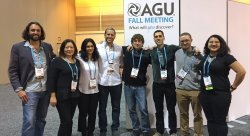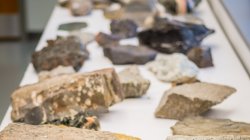EAES department well represented at annual AGU conference
The American Geophysical Union held it’s conference in New Orleans Louisiana where multiple faculty and students attended and presented.
Posted in: Department Research

Jesse Kolodin, Environmental Management PhD student, presented a poster on a coupled “geo-economic” model, which looked at the human-natural interaction of New Jersey’s newly installed artificial berm-dune shorelines. The project has the potential to provide more insight into the sustainable nature of these shorelines, based on the local municipality’s economic feasibility into the future. He explained his experience at the conference:
I felt that AGU did a fantastic job coordinating the flow of the weekend, as well as providing the attendees with some additional fun and exciting facets of New Orleans, all within the walls of the conference. Just the shear size and vastness of science that was happening made for an overall enjoyable and awe-inspiring weekend.
Jesse broke things down further discussing his poster presentation and takeaways from the week:
The feedback I got regarding my poster was extremely helpful and insightful. Not only did I meet a wide range of scientists with various backgrounds, the main scientists in my field were on hand to challenge me and provide great feedback that has helped my manuscript (in progress) become an even more powerful piece of literature.
The rest of the conference week had a lot of interesting and insightful material available. As it turns out, the geomorphology group decided to lump our specific field into lectures occurring Mon-Wed, but I found other, non-related talks and posters that provided me more insight into further developing my own research. The field of science available, outside of geomorphology, was extremely vast and made for a very exciting week. On Saturday, the main group of geomorphology scientists from around the world were in attendance for AGU’s annual Gilbert Club meeting, which occurred on the campus of Tulane University. This event went from 8am till 7pm that day and allowed for numerous networking opportunities, as well as the top presentations from across the field.
My experience at AGU was incredible. I felt inspired by the wealth of knowledge and breadth of novel scientific inquiry. The conference served both as a learning experience and career networking opportunity. Collaboration across the research community provided a glimpse into academia as a career path.
Arye presented his coupled geo-economic model exploring hard structure impacts on coastal socioeconomics and management strategy. The aim of the project is to compare possible responses to localized erosion hotspots, namely beach nourishment and managed retreat through federal property buyouts.
The AGU is a good opportunity to meet with several disciplines in Earth Sciences and from all over the world. It is also a great occasion to receive very productive feedback and to meet new people sharing our same interests. This conference gives students an opportunity to meet with experts and well-known researchers, developing a network that will be crucial after graduation.
I had a wonderful experience at the 2017 AGU Fall Meeting. I discussed my research with other students and scientists who are conducting similar work, and learned about current research projects in other fields. It was great being exposed to possible collaboration opportunities with different agencies and universities. I was awarded a $500 Student Travel Grant from the American Geophysical Union to attend the 2017 Fall Meeting. I was also selected as an AGU Student Volunteer, which had only a few dozen open positions, and earned free student registration.
Yaritza presented on her research focused on New Jersey freshwater phytoplankton assemblages that are poorly known and establishing a list of freshwater phytoplankton taxa in New Jersey. This study suggested that there were cyanobacterial taxa present in 42 out of 64 sampling sites in freshwaters of New Jersey. The most commonly found taxa, Anabaena spp., are capable of simultaneously producing multiple toxins including endotoxins, hepatotoxins, neurotoxins and taste and odor compounds, which exemplifies the difficulty of management and treatment as well as increased public health effects. Active monitoring is suggested for those lakes with possible cyanotoxin-producing taxa. Management of cyanobacterial blooms, including point and non-point source pollution control, is imperative in freshwaters of New Jersey.
